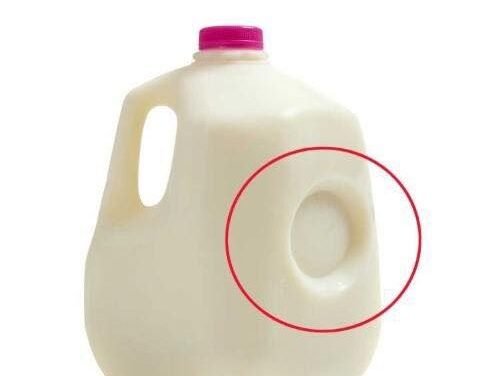
Have you ever picked up a gallon of milk, perhaps to whip up a batch of creamy Crockpot Nacho Dip, and noticed that peculiar circular indentation on one side of the plastic jug? It’s often overlooked, a seemingly insignificant design quirk. But if you’re anything like me – curious about the “why” behind everyday objects – you might have wondered: What’s the deal with that dent? Is it just a manufacturing imperfection? A handle for tiny hands? Or something else entirely?
As a food enthusiast and someone who spends a lot of time in the kitchen, I’ve come to appreciate the nuances of food packaging. It’s not just about aesthetics; often, there’s clever engineering at play. And the humble milk jug dent is a perfect example of design serving a very important, albeit often invisible, function.
Why I Love This Little Detail
I find it fascinating how everyday items are designed with such precision and purpose. The milk jug dent is a testament to thoughtful engineering, prioritizing safety and freshness, two things I value greatly when it comes to ingredients for my recipes, whether it’s for a refreshing Blueberry Lemonade or a hearty Mexican Chicken and Rice Casserole. This seemingly small detail plays a critical role in preventing messy spills and ensuring the quality of the milk we consume. It’s a silent guardian in our refrigerators!
The Purpose of the Dent: It’s All About Pressure
The primary purpose of that circular dent on the side of plastic milk jugs is to act as a pressure relief valve. Milk, especially pasteurized milk, is a perishable product that needs to be kept cold. However, even within the controlled environment of a refrigerator, slight temperature fluctuations can occur. These fluctuations can cause the milk inside the jug to expand or contract.
Here’s how it works:
- Expansion: If the milk warms up slightly (for example, if the jug is left out on the counter for a short period, or if your refrigerator has a warm spot), the milk will expand. This expansion creates pressure inside the sealed jug. Without a mechanism to absorb this pressure, the jug could bulge, potentially crack, or even burst, leading to a huge, sticky mess. The dent is designed to “pop out” to accommodate this internal pressure.
- Contraction: Conversely, if the milk gets very cold (for instance, if it’s placed against a very cold part of the refrigerator or experiences a significant drop in temperature), the milk will contract. This creates a vacuum inside the jug, pulling the sides inward. The dent is designed to “pop in” to relieve this negative pressure, preventing the jug from collapsing.
Think of it as a built-in accordion for your milk jug, allowing it to adapt to changes in its internal environment.
Beyond Pressure: A Freshness Indicator
While primarily for pressure regulation, the dent can also serve as a subtle indicator of milk freshness, though it’s not its main purpose. If your milk jug’s dent is consistently popped out and rigid, it could indicate that the milk has been exposed to warmer temperatures for too long, leading to increased pressure from bacterial growth and spoilage. Always rely on the “best by” date for true freshness, but a consistently bloated jug is definitely a sign to investigate further.
Why Only Plastic Jugs?
You’ll typically only find this dent on plastic milk jugs, not on cardboard cartons or glass bottles. This is because:
- Plastic’s Flexibility: Plastic is a flexible material, making it ideal for this pressure-absorbing design. Cardboard cartons have a different structural integrity and are less prone to bulging or collapsing from minor pressure changes.
- Sealing: Plastic jugs are hermetically sealed, meaning they are airtight. This tight seal, combined with the milk’s susceptibility to temperature changes, necessitates the pressure-relief mechanism. Glass bottles, while also sealed, are much more rigid and are less likely to deform under these conditions (though they too can break under extreme pressure).
A Small Detail, A Big Impact
It’s truly remarkable how such a small, often unnoticed detail can play such a crucial role in the safety and quality of the products we consume. The next time you grab a gallon of milk, take a moment to appreciate that unassuming dent. It’s a silent testament to the thoughtful engineering that goes into everyday packaging, working hard to ensure your milk stays fresh and your kitchen stays clean.
More Recipes You Will Love
Now that you’ve got a newfound appreciation for your milk jug, why not put that milk to good use?
- Make a batch of Crockpot Nacho Dip – perfect for a crowd!
- Whip up some Mexican Chicken and Rice Casserole for a comforting weeknight meal.
- Enjoy a refreshing glass of Blueberry Lemonade on a sunny day.
- Treat yourself to The Best Peanut Butter Brownies I’ve Ever Made.
- Indulge in a Grasshopper Pie for a delightful dessert.
Final Thoughts
The world of food and its packaging is full of fascinating little secrets. Understanding these details not only satisfies our curiosity but also helps us appreciate the science and effort that goes into bringing food safely from farm to table.
Did you know about the purpose of the milk jug dent? Share your thoughts and any other interesting food packaging facts you know in the comments below! Don’t forget to follow Chefmaniac for more culinary insights and delicious recipes.




Leave a Reply